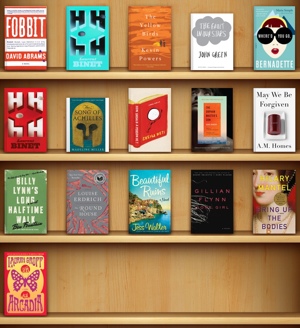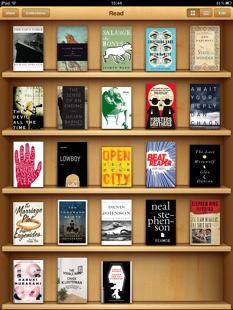
The 2013 Tournament of Books starts on Monday, and the brackets were announced yesterday. There’s a great tournament diagram available for download, but rather than try to figure out how to fill it in electronically so it was legible, I generated a traditional bracket-style diagram with my picks filled out (at the bottom of the post).
The diagram creation script I wrote last year doesn’t include a pre-round bracket, used this year to decide between Billy Lynn’s Long Halftime Walk (my pick), Fobbit, and Yellow Birds, so I just filled in the obvious (to me!) choice in the top spot of the first round.
The first round presents some challenges for the judges. I’ll be interested in the contest between Bring Up the Bodies and HHhH both of which are historical fiction and were very good. Mantel’s previous book in the story of Thomas Cromwell (Wolf Hall) won the Tournament in 2009, and Bodies is as good as that book. But HHhH is an creative and entertaining mix of semi-fiction, history, and the author’s thoughts and concerns about the story / history he is writing. It’s a different style of book than what is typically in the Tournament (although more traditional that Building Stories, I suppose), and I wonder how it will compete against such an obvious favorite to win.
The Round House vs. The Fault In Our Stars and The Orphan Master’s Son vs. Where’d You Go, Bernedette are contests between excellent books that are completely different in tone and subject (Native American sexual assault and terminal cancer in adolescents / North Korean oppression and madcap antics from a stifled architectural genius). Instead of getting two pairings that are similar in the first round (like Bodies and HHhH) and then two very different books in the second, the different books will be competing against each other initially.
Although Billy Lynn has acheived some literary notariety and is the book I’d like to see win, I think the real heavyweights in the Tournament are Gone Girl and Bring Up the Bodies. I expect to see these two go far, maybe to the final round.
Finally, will there be another book that goes deep into the Tournament that I really didn’t like (like Lightning Rods last year)? I didn’t even try to read Dear Life, couldn’t finish Ivyland, and didn’t enjoy How Should a Person Be? I’m hoping for round one elimination for these books.
Get your diagrams ready and start reading the results on Monday!

Recently read iBooks
The Morning News Tournament of Books starts next week, and I’m about a third of the way through the only unread volume in this year’s contest, Téa Obreht’s The Tiger’s Wife. In preparation for my posts on the tournament, I wanted to generate a tournament bracket, filled with my choices. I could have fired up Inkscape or my favorite old drawing program, xfig, but drawing something that has such an obvious pattern built into it would be much easier using a programming language rather than moving a mouse pointer around over and over again.
I debated refreshing my Metapost skills, the tool I used to generate my best baseball scorecards, and even wrote a simple Pic (a language written in 1982 by Brian Kernighan, of K&R and awk fame) macro to do it. But I wanted something that would work on the web, and for figures on the Internet, SVG is really the best format (well, unless you’re stuck on Internet Explorer…). Metapost and Pic produce PostScript and PDF, and I wasn’t happy with the way the available PS to SVG image converters mangled the Pic PostScript.
I settled on Python (of course!) and the svgwrite library. Generating an SVG file programatically is pretty easy with svgwrite. You start the drawing with:
svg = svgwrite.Drawing(output_filename, size = ("700px", "650px"))
and then draw stuff onto the page with commands like those found in my draw_bracket function. The all-caps variables are global parameters set at the top of the code to control the size of various elements across the entire figure. I also created a Point class for handling x / y coordinates in the diagram. That’s what start is defined as below (and how I can access x and y via start.x and start.y.
def draw_bracket(svg, start, width, height, names):
""" Draw a bracket from (start.x, start.y) right width, down height,
to (start.x, start.y + height), placing the names above the
horizonal lines. """
lines = svg.add(svg.g(stroke_width = 2, stroke = "red"))
lines.add(svg.line((start.x, start.y), (start.x + width, start.y)))
lines.add(svg.line((start.x + width, start.y),
(start.x + width, start.y + height)))
lines.add(svg.line((start.x + width, start.y + height),
(start.x, start.y + height)))
texts = svg.add(svg.g(font_size = TEXT_SIZE))
texts.add(svg.text(names[0],
(start.x + TEXT_RIGHT, start.y - TEXT_UP)))
texts.add(svg.text(names[1],
(start.x + TEXT_RIGHT, start.y + height - TEXT_UP)))
With this function, all that’s left is to design the data structures that hold the data in each column of the diagram, and write the loops to draw the brackets. Here’s the first loop:
# ROUND 1
current_start = Point(MARGIN, MARGIN)
for bracket in first_brackets:
print(current_start)
draw_bracket(svg, current_start, INIT_BRACKET_WIDTH,
FIRST_BRACKET_HEIGHT, bracket)
current_start = current_start + \
Point(0, FIRST_BRACKET_HEIGHT + FIRST_BRACKET_SKIP)
first_brackets is a tuple of paired tuples, so each bracket above contains the two book titles that should appear on each leg of that bracket.
first_brackets = (
("Sense of an Ending", "The Devil All the Time"),
("Lightning Rods", "Salvage the Bones"),
...
)
The full code can be downloaded at make_bracket.py. The result:
I’ll comment more on my picks after I’ve finished The Tiger’s Wife, and as the tournament starts next week. There were a lot of great books in the tournament, and I wouldn’t be disappointed if some of the later bracket winners in my diagram wound up winning. For me, the most interesting first round bracket is Wil Weaton’s tough choice between Ann Pachett’s State of Wonder and The Sisters Brothers by Patrick deWitt. I chose Sisters, but it was a tough choice, and even though it doesn’t make it past round one on my diagram, I’d be happy to see Wonder win it all.
One other note on the screenshot from my iPad at the top of the post. There are several excellent, non-Tournament books pictured. I highly recommend The Last Werewolf, by Glen Duncan, Neal Stephenson’s Reamde, 11/22/63 (Stephen King), and Eleanor Henderson’s Ten Thousand Saints. These four are easily better than the worst of this year’s Tournament (Hollinghurst, DeWitt and Zambreno).